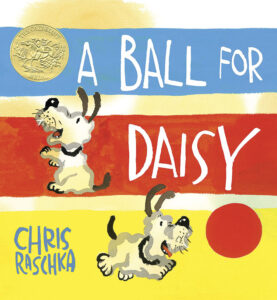Awareness of emotions
Toddlers make happy and sad faces as part of a review of a story about feeling happy and sad.



[Invite several toddlers to join you to make happy and sad faces.]
 Sometimes things happen that make us feel happy. Sometimes things happen that make us feel sad.
Sometimes things happen that make us feel happy. Sometimes things happen that make us feel sad.
[Show book cover.]
A while ago we read this book about a dog named Daisy. Daisy liked to play with a favorite ball. One day a larger dog took Daisy’s ball. The larger dog broke the ball. Then a friend gave Daisy a new ball.
Let’s look at some pictures of things that happened in this book.
[Display book illustrations that show the following in the order in which they happened: (1) playing with red ball, (2) lying on couch with red ball, (3) bigger dog taking Daisy’s favorite ball, (4) favorite ball being destroyed by bigger dog, and (5) a friend giving Daisy a new ball. For each illustration:
We talked about feeling happy and feeling sad. Things happened that made Daisy feel happy. Things also happened that made Daisy feel sad. Our face can tell people how we are feeling.
Happy and sad feelings were explored with this book in Block 14 (Social-Emotional). The story is reviewed in the current activity with a combination of different strategies pursued for key events. The strategies were not offered in a combined manner in Block 14. The strategies are used together in a repetitive approach in the current activity to strengthen toddlers’ awareness of happy and sad feelings. Happy and sad are typically the first emotions young children learn to name. Some toddlers may prefer to watch others make happy and sad faces rather than offer a happy or sad expression with their own face. Positively acknowledge all forms of participation.
Extra support
Enrichment
Awareness of emotions
Toddlers are encouraged to use different ways to communicate feeling happy or sad in response to a pretend event described by a caregiver.

None


Invite several toddlers to join you to talk and sing about feeling happy or sad. Describe two pretend situations, one at a time, and encourage toddlers to communicate with words, facial expressions, and song how the situation might make them feel. Use the following order:
This short activity is intended to reinforce toddlers’ awareness of how happy and sad feelings can be communicated. Toddlers may differ in whether they participate in each of the different forms of communication offered in the activity: saying the feeling word, making a facial expression that shows the feeling, and singing about the feeling with actions. Inviting toddlers to use the feeling word in a brief sentence may seem unnecessary after they identify a feeling, but an important step in awareness of feelings is to say how we feel.
Elaborate slightly on your verbal description of a situation if it appears toddlers are confused about the pretend arrangement. It is cognitively challenging to imagine an event without a picture or props. Use situations that most toddlers in your room will have experienced or watched.
Extra support
Enrichment
Materials Needed: pictures of different common facial expressions
Display on a wall or room divider some pictures of young children (preferably toddlers or preschool-age children) showing different facial expressions. Talk with individual or several toddlers about the expressions. Point to facial features you or the toddler mentions. Encourage the toddler(s) to join you in making a similar expression. Emphasize how each of us may make a different kind of happy or sad face.
Materials Needed: none
In Option 2, invite preschool-age or older children to lead toddlers in making a happy or sad face and in singing an appropriate verse of the suggested song. An older child may wish to show several different versions of happy and sad faces. Some smiles are bigger than others. Some frowns are more pronounced than others. An older child can help show there are different types of happy and sad faces.